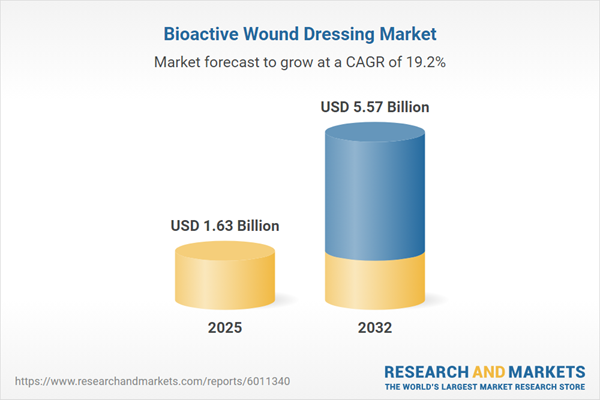Speak directly to the analyst to clarify any post sales queries you may have.
The bioactive wound dressing market is experiencing rapid transformation, driven by technological advancements and evolving clinical demands. Innovations in bioactive dressing solutions are reshaping therapeutic strategies and setting a new standard in patient care across diverse healthcare environments.
Market Snapshot: Bioactive Wound Dressing Market Size and Growth Outlook
The bioactive wound dressing market grew from USD 1.36 billion in 2024 to USD 1.63 billion in 2025. It is expected to accelerate at a CAGR of 19.17%, reaching USD 5.57 billion by 2032. This expansion reflects strong clinician demand, increased prevalence of chronic wounds, and a shift toward biologically active treatment options supported by regulatory and reimbursement momentum.
Scope & Segmentation: Defining the Evolving Landscape
- Product Types: Alginate (including calcium and sodium formulations), composite (featuring collagen or multi-layer compositions), film (semipermeable and transparent), foam (ethyl vinyl acetate or polyurethane), hydrocolloid (block and calcified types), and hydrogel (amorphous and sheet forms).
- Indications: Suitable for burns (covering full and partial thickness), diabetic foot ulcers (ischemic, neuroischemic, neuropathic), pressure ulcers (stratified by clinical stage), surgical and traumatic wounds, and venous leg ulcers.
- End Users: Ambulatory surgical centers, clinics (outpatient and private settings), home care (caregiver-assisted and self-application), as well as hospitals (specialty and tertiary care facilities).
- Distribution Channels: Hospital pharmacies, online pharmacies (including business-to-consumer websites and e-commerce platforms), and retail pharmacies (chain and independent).
- Material Choices: Bioengineered skin replacements (epidermal and dermal), natural polymers (alginate, chitosan, collagen from bovine, marine, or porcine sources), and synthetic polymers (polyethylene, polyurethane).
- Regions Covered: Americas (United States, Canada, Mexico, Brazil, Argentina, Chile, Colombia, Peru), Europe (including Germany, France, United Kingdom, and more), Middle East (UAE, Saudi Arabia, Turkey, Israel, Qatar), Africa (South Africa, Nigeria, Egypt, Kenya), Asia-Pacific (China, India, Japan, Australia, South Korea, Southeast Asian countries).
- Company Portfolio Reviewed: Major producers such as Smith & Nephew, Mölnlycke Health Care, 3M, ConvaTec, Coloplast, Johnson & Johnson, Cardinal Health, B. Braun Melsungen, Integra LifeSciences, and Organogenesis.
Key Takeaways: Insights Shaping Market Success
- Bioactive wound dressings are moving from passive protection toward dynamic therapeutic platforms that deliver growth factors, antimicrobials, and matrix components to injury sites, supporting faster and more reliable healing pathways.
- Material science breakthroughs—such as smart polymers and collagen composites—are enabling custom dressing configurations responsive to wound conditions like pH and moisture, giving healthcare providers greater precision.
- Personalized medicine is now influencing dressing selection, with patient biomarkers guiding therapy to maximize efficacy while minimizing complications, especially in complex or chronic cases.
- Digital integration is rising; connected dressings and monitoring tools facilitate personalized care, optimize resource use, and create new service offerings that build competitive differentiation.
- Emerging partnership models—spanning biotechnology companies, material suppliers, and academic organizations—are accelerating innovation cycles and extending distribution reach across regions with varying regulatory standards.
- End users reflect the market’s need for efficiency, from rapid-adhesion dressings in surgical settings to cost-effective self-care solutions at home, segmenting the market by application and care environment.
Tariff Impact: Strategic Sourcing Under Shifting Trade Policy
The 2025 introduction of tariffs on imported medical materials has prompted strategic reassessment among bioactive wound dressing suppliers. Manufacturers are exploring long-term contracts with domestic sources, investing in additive manufacturing and local bioprocessing, and considering vertical integration to control raw material costs. These adaptive strategies enhance supply chain stability and protect margins amid volatile pricing, ultimately shaping procurement models for hospitals and clinics seeking budget predictability.
Methodology & Data Sources
This report was developed using a rigorous research methodology, integrating primary data from expert interviews (including clinicians, regulatory experts, and supply chain executives) with secondary analysis from industry reports, peer-reviewed journals, and company filings. Quantitative modeling and segmentation analysis ensure comprehensive and reliable insights into this rapidly evolving market.
Why This Report Matters for Senior Decision-Makers
- Enables strategic planning by highlighting product, end-user, and material trends that influence purchasing and innovation strategies.
- Guides risk management by clarifying the impact of trade policy, regulatory adaptation, and supply chain shifts on operational resilience and cost containment.
- Supports competitive positioning and growth through practical intelligence on emerging collaboration models, digital health integration, and reimbursement frameworks.
Conclusion
The bioactive wound dressing market is advancing rapidly, underpinned by technology, regulatory developments, and changing clinical needs. Companies that act with agility, align with evolving care models, and leverage robust partnerships will be positioned to influence this dynamic landscape.
Additional Product Information:
- Purchase of this report includes 1 year online access with quarterly updates.
- This report can be updated on request. Please contact our Customer Experience team using the Ask a Question widget on our website.
Table of Contents
3. Executive Summary
4. Market Overview
7. Cumulative Impact of Artificial Intelligence 2025
Companies Mentioned
The companies profiled in this Bioactive Wound Dressing market report include:- Smith & Nephew plc
- Mölnlycke Health Care AB
- 3M Company
- ConvaTec Group plc
- Coloplast A/S
- Johnson & Johnson
- Cardinal Health, Inc.
- B. Braun Melsungen AG
- Integra LifeSciences Holdings Corporation
- Organogenesis Inc.
Table Information
| Report Attribute | Details |
|---|---|
| No. of Pages | 190 |
| Published | October 2025 |
| Forecast Period | 2025 - 2032 |
| Estimated Market Value ( USD | $ 1.63 Billion |
| Forecasted Market Value ( USD | $ 5.57 Billion |
| Compound Annual Growth Rate | 19.1% |
| Regions Covered | Global |
| No. of Companies Mentioned | 11 |









